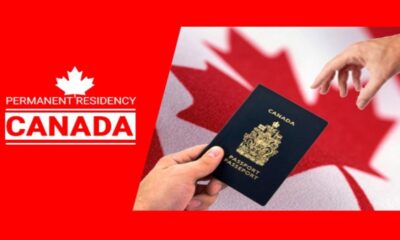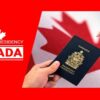Immigration
The Schooling Experience in Canada: A guide for new families in Canada
Is your family planning to move to Canada?
In this instance, you are likely familiar with Canada’s reputation throughout the world for its quality of education and schooling system. Canada heavily depends on taxpayer-funded public programs, such as social services, healthcare, and education. Most Canadians and newcomers (that’s the majority of you!) believe that the tax they pay is well-invested to fund the nation’s robust education system.
What is the quality of Canada’s educational system?
Canada is home to an outstanding education system. According to a survey for 2020, Canada is viewed as having the third best educational system in the world. A detailed analysis by Statistics Canada shows Canadians spend about 6% of their GDP (GDP) on education. This is more than the average for all countries that are members of the Organisation of Economic Co-operation and Development (OECD).
As is the norm, money invested in the education system within Canada appears to be paying off. In Canada, 91 percent of people aged 25-64 have at least a high school degree, with the majority holding a postsecondary certificate. These figures are far above OECD standards and illustrate that education plays a significant role in Canadian society.
It isn’t to say that education in Canada is flawless. Certain schools have large class sizes and the ratio of students to teachers (although COVID-19 has impacted the size of classes in certain districts). Some schools provide limited extracurricular activities, arts and sciences, and sports compared to other schools. Certain schools have fewer choices for courses and academic programs. Because of this, it is essential to conduct some prior research, as ultimately, you’ll be the most influential voice for your child’s education.
Are you ready to go to school? Classes are in session.
What are the most important things you should be aware of about the schooling system in Canada before your arrival?
It is the Canadian system of Preschools and Pre-Kindergarten Elementary & Secondary School Questions in Postsecondary Schools.
Significant decisions: Your home will determine where your child attends school, or where you would like your child to attend school will determine where you decide to reside. You have the option.
In the case of your child’s education, doing your research before bringing your child into Canada could have an immense difference in the quality of their education.
Education in Canada is primarily managed at the provincial/territorial level, meaning that the system in Ontario will differ from that in British Columbia, and so on. Within the province, education may be different between different types of schools and districts.
Making sure your child is educated is similar to dealing with a Canadian immigration system. There are some essential things that you need to master from the beginning, and as long as you make an effort to study yourself on your own, you’ll find able to make the right choice in the matter of educating your child.
Before we dive deep into the ins and outs of learning, we’ll talk about one of the most important things you’ll require to have in a Canada A bank account. This guide was created in collaboration with HSBC Bank Canada and is here to assist newcomers in settling into Canada through their Newcomers Program, which is worth up to $1,350. *
Discover more about HSBC Canada Newcomers Program and learn how to earn as much as $1350* once you start with HSBC. Issued by HSBC Bank Canada.
Knowing how to work with the Canadian education system
There are three stages to the Canadian education system divided into three phases: preschool or pre-kindergarten, elementary and secondary education (also known as K-12), and postsecondary. While some provinces have distinctions, distinct characteristics are unique to each stage.
Preschool or pre-kindergarten
Preschool, also known as pre-kindergarten, is an opportunity to learn for youngsters, usually between three and five years of age. It is up to you to decide whether you would like to start a preschool program for your child. The preschool and related early-childhood education programs are accessible in certain provinces; however, in some provinces (and for specific privately run programs), parents might be required to pay.
Preschool is not as rigorously organized as the obligatory phases of secondary and elementary school. This means you have various choices regarding preschool programs, curriculums, schedules, and costs. It is essential to investigate the options in the area you’re planning to visit and make sure you apply early since waiting lists for specific preschool programs are long.
Another option for preschoolers is daycares. These are places for children to play with staff members overseeing and caring for children. They typically allow a more significant age group of children to be part of the fun since they are primarily geared towards caring for children of parents who work. Although daycares aren’t explicitly educational, many daycares have education-related activities as a component of their services.
Enrolling your child into daycare or preschool is entirely up to you. However, it is widely accepted that the early stages of children’s existence can be pivotal in developing social skills, personality, and personal development. However, a daycare or preschool experience is not the only way to encourage the development of this kind. Parents in Canada are committed to encouraging the development of their children’s early years their children in more informal environments by encouraging activities at home or participation in community play groups.
Pro-tip: Make sure to look into early preschool education in the province of residency in Canada. Certain provinces provide subsidized access to specific preschooling as well as childcare facilities. COVID-19 has also led to the reduction of space in certain daycares, where government-mandated limits on enrolment have been imposed.
Secondary and elementary education
In Canada, It’s not only your moral obligation as a parent but also to ensure that your child is provided with an education. It’s legally required (vital education and stable societies!). Primary and secondary education are required components of a child’s schooling in Canada.
Secondary and elementary education follows an identical structure throughout Canada; however, the provinces have minor variations. Most education begins at five or six and starts with a single calendar year at kindergarten. Then, there are the twelve “grades” of schooling, each lasting a year. After finishing Grades 1-12, the child is awarded a high school diploma. They could then be eligible to pursue postsecondary education.
Local oddities:
- The Ontario, Kindergarten is divided into two years: Senior Kindergarten (for 4-year-olds) and senior kindergarten (for 5-year-olds). The latter is not a requirement.
- These days, in Quebec, the primary and secondary schools are broken down into six grades and then five “secondary levels” (Sec I-V) that only amount to 11 years. After the completeness of Section V, students have the option of attending CEGEP (Collège d’enseignement général et professionnel). CEGEPs are an amalgamation of high-school and college/university education, usually providing a semi-specialized program based on a student’s passions or career goals.
- In Nova Scotia, kindergarten is known by the term primary.
Because both primary and secondary education is required and play an essential part in the development of a child, We’ll focus on this subject a little longer and address many of the most frequently asked questions:
Types of schools Language of instruction When do schools start? | Ages for schooling | Elementary–Middle–Junior High–High School | Subjects covered | Extracurriculars & Special Programming | Special Needs & Disabilities | School Boards
What kind of schools are there across Canada?
There are three choices for secondary and elementary education in Canada.
- Schools for the public: Schools funded by the public are open to students from every province across Canada. They are free for kids to attend (funded by the same tax-payer system that provides health and social assistance!). A majority of children in Canada go to a public school.
- Private schools: These schools are run by private companies and usually require parents to pay tuition to enroll their child in the school. Around seven percent of kids in Canada go to private schools. The tuition fees for private schools can be very different.
- The homeschooling process: It is an option that allows parents to leave their children at home and help them learn independently. The regulations for homeschooling vary from province to province. However, parents often discover suggested curricula and additional materials on the internet. Only a tiny fraction of the children living in Canada are homeschooled.







